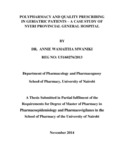| dc.description.abstract | Polypharmacy is the use of multiple medicines (at least five types of medicines) to treat a single
patient. Polypharmacy can have positive and negative consequences. Therefore, it is important to
distinguish between rational and irrational polypharmacy. Prescription quality, good prescribing
practices as well as good dispensing practices are important in avoiding irrational polypharmacy.
The elderly are at a risk of negative consequences of polypharmacy because of the
pharmacokinetic and pharmacodynamic changes that occur as people age. In addition, such
patients tend to present with different disease patterns, often including two or more concurrent
diseases, and have altered, usually slower response to treatment.
Objective:
The objective of this study was to establish the frequency and characteristics of irrational
polypharmacy and inappropriate medication use among geriatric patients at the Nyeri Provincial
General Hospital.
Methodology:
This study was a cross-sectional study that involved the collection and analysis of demographic
and treatment data from medical records and interviews of patients aged 65 years and older and
who attended the medical outpatient clinic (MOPC) or were admitted to the medical inpatient
wards at Nyeri Provincial General Hospital between 1st January and 31st December 2013.
Results:
The prevalence of polypharmacy among patients in Nyeri PGH was found to be 5.15% (N=22).
Of all the prescriptions that exhibited polypharmacy (N=22) the proportion of those with
inappropriate medicines was 50% (n=11) and those with underused medications was 13.63%
(n=3). On the other hand the prevalence of inappropriate prescriptions in patients who did not
experience polypharmacy (N=405) was 15.8% (n= 64) and the prescriptions with underused
medicines was 3.7% (n=15).
After logistic regression, sex, polypharmacy and the number of drugs per prescription were
found to be independent predictors of inappropriate prescribing among these geriatric patients.
xiii
This study established that males had lower odds than females of having inappropriate
medication in their prescription. Also, the presence of polypharmacy raises the odds of
inappropriate prescribing, as does an increase in the number of drugs prescribed. Pain
medications (NSAIDS) were the most inappropriately prescribed medicines, followed by
anticholinergics, central nervous system drugs and cardiovascular system drugs.
Twenty five patients were interviewed so as to qualitatively explore the possible outcomes of
polypharmacy. One patient had difficulty in keeping track of their medicines, 7 had trouble
taking their medicines, 19 patients could not describe the purpose of their medicines, 21 had
difficulty in understanding the instructions on their medications, 1 patient reported that they
experienced an ADR, 3 patients saw more than one doctor and 12 patients visited more than one
pharmacy.
Discussion:
The results were consistent with findings from other studies, though the frequency of
polypharmacy in Nyeri Provincial hospital was quite low compared to those found in other
studies. Polypharmacy is common problem especially in non-government medical institutions
and hospitals compared to Government hospitals. The main reason for this is the limited number
of available drugs in the Government hospital formularies compared to the larger number of
drugs that are available in the private sector and that most of these geriatric patients are retired
with no source of income making them have financial restraints.
Most patients in general strive to take their medications as prescribed, but some may not be able
to adhere to medication regimens due to lack of understanding, forgetfulness or confusion. Also
poor vision and poor manual agility may further reduce adherence as was observed with patients
on insulin in this study.
Conclusion:
Awareness of polypharmacy is needed so as to promote routine evaluation of medicines for
efficacy, reduce ADRs and make medical practitioners aware of the principals of geriatric
medicine. All medicines without therapeutic indication or gain should be eliminated so as to
prevent unnecessary ADRs | en_US |
| dc.description.department | a
Department of Psychiatry, University of Nairobi, ; bDepartment of Mental Health, School of Medicine,
Moi University, Eldoret, Kenya | |

